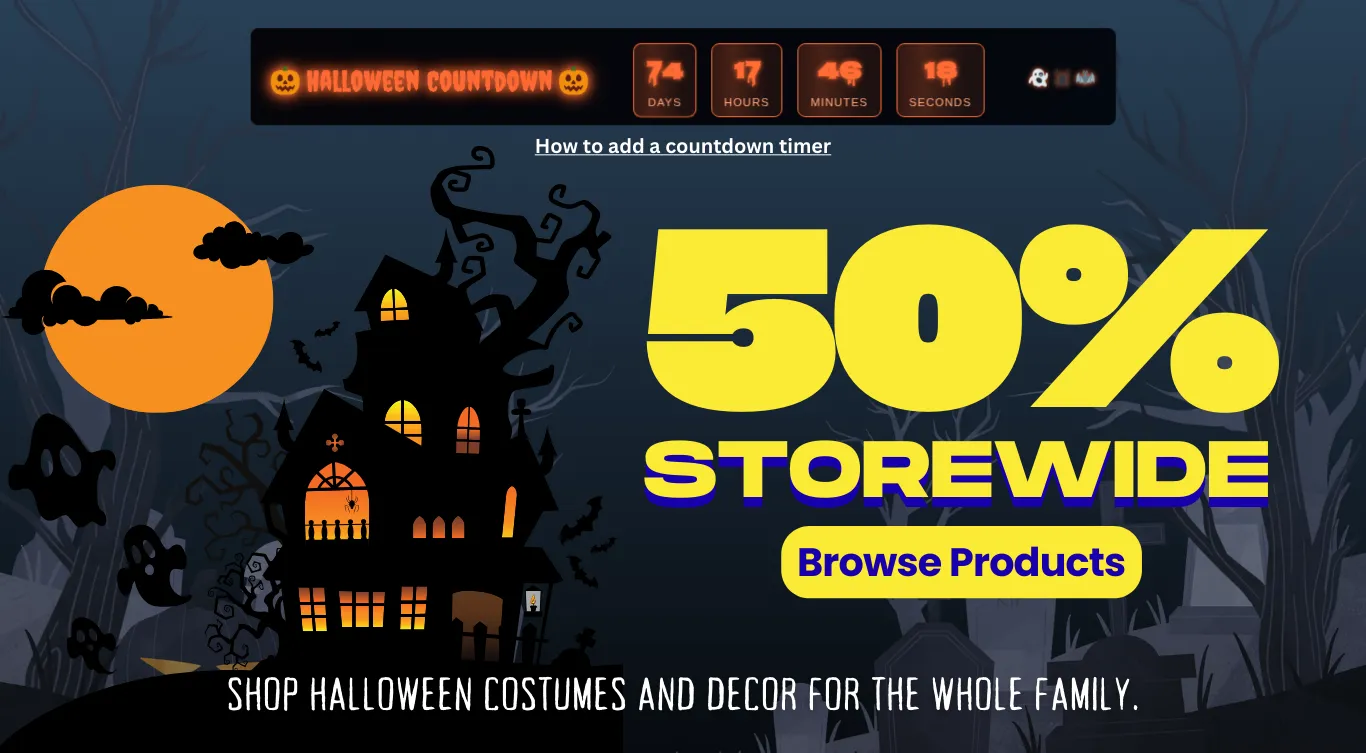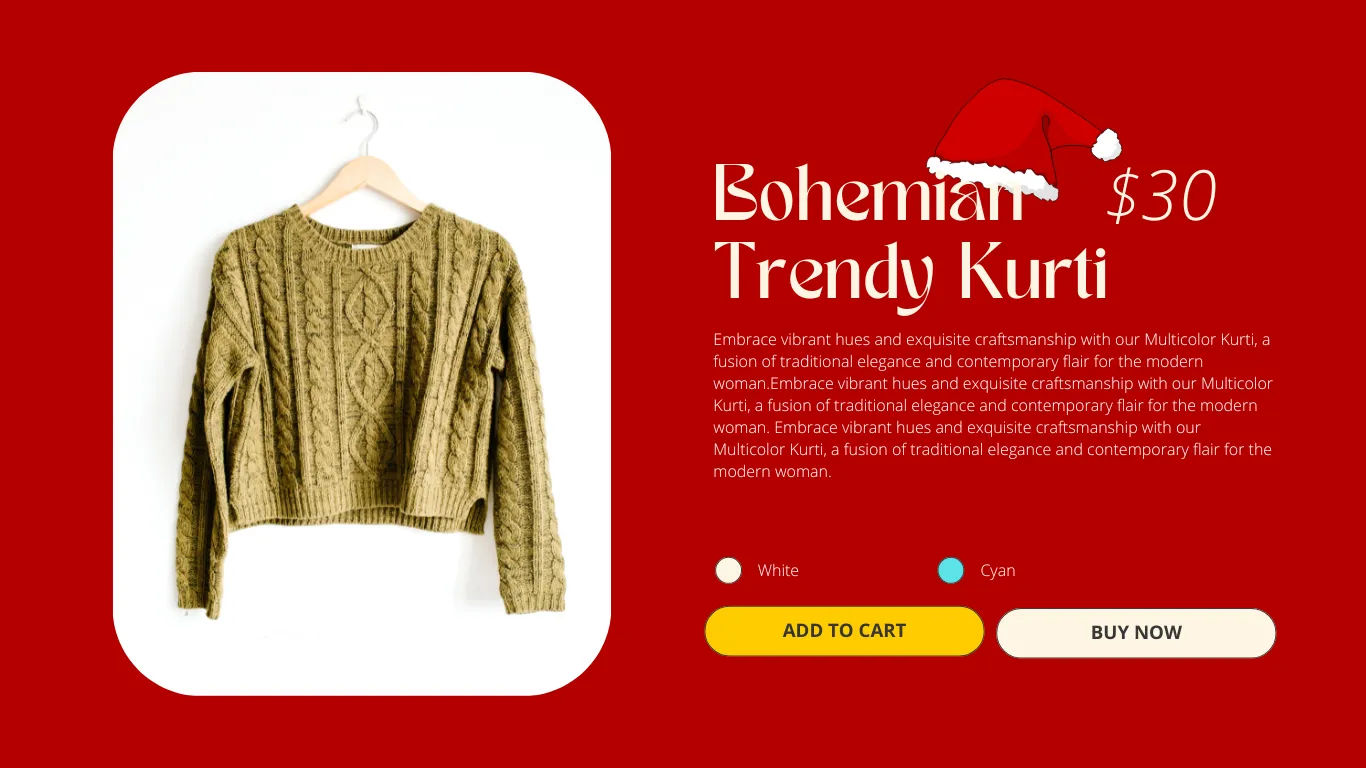How to Start a Jewelry Dropshipping Business on Shopify: Complete Guide
Thinking of starting a jewelry dropshipping business on Shopify? Great choice! The online jewelry market is booming: it’s projected to reach $105.6 billion in 2024 (a 13.2% annual increase) and continue climbing toward $166 billion by 2029 source. Jewelry falls under the fashion category, which consistently ranks among the top e-commerce categories worldwide. In fact, Shopify’s own team highlights that jewelry sells well on the platform, noting successful Shopify jewelry brands like Missoma and Mejuri as proof.
In this guide, I’ll walk you through everything I’ve learned as an e-commerce expert about launching a profitable jewelry dropshipping store on Shopify: from choosing your niche to designing your store, attracting customers, and optimizing for sales.
Why Jewelry Is a Great Dropshipping Niche
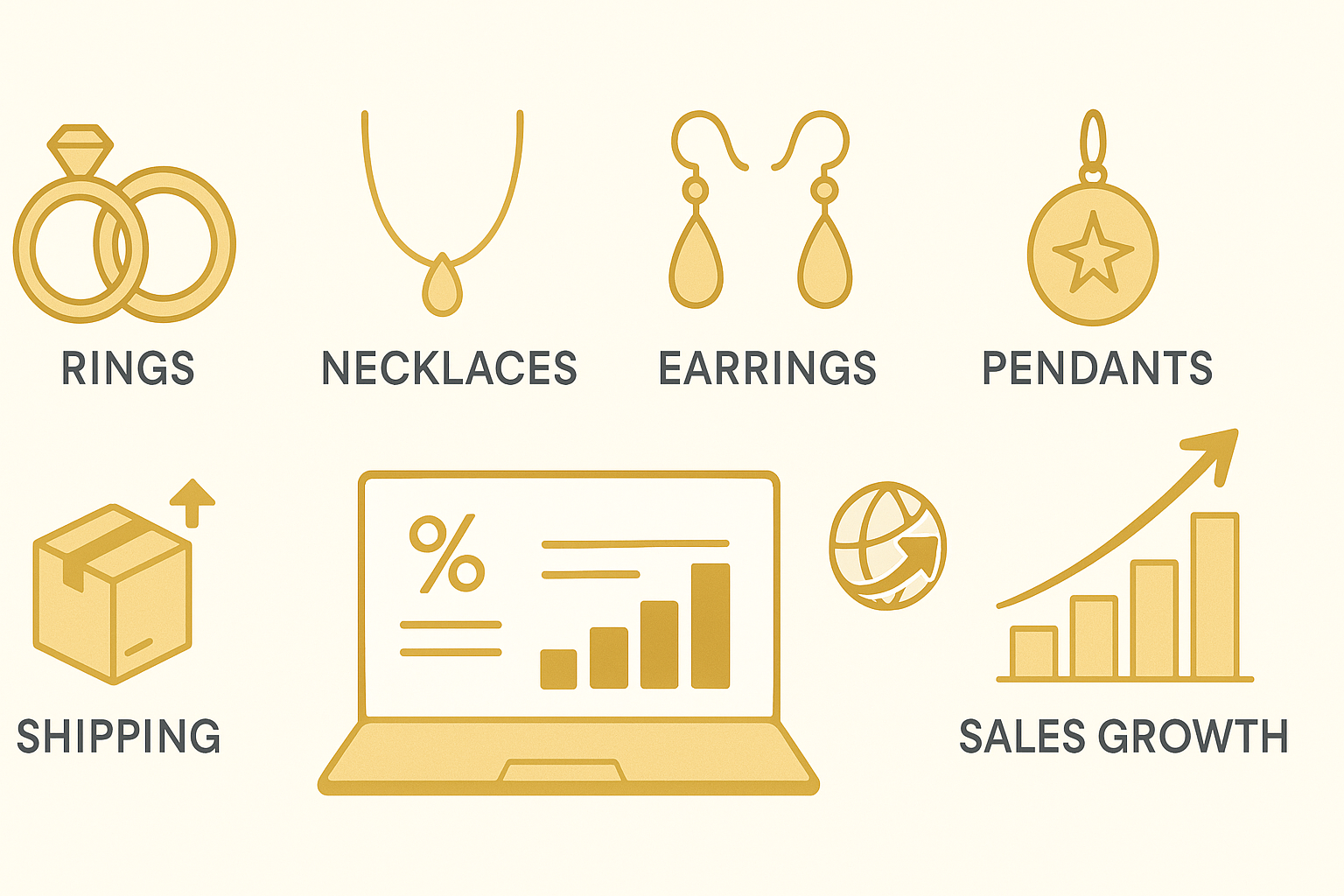
Jewelry is an ideal niche for new Shopify entrepreneurs for several reasons:
-
High demand & emotional appeal
Universal gifting + style purchase; trends like minimalist, personalization, “everyday luxury” drive steady interest and impulse buys. -
Low shipping costs
Small, lightweight items reduce costs, make free shipping feasible, and let you order samples for content without overspending. -
High profit margins
Low wholesale cost + high perceived value; 4–5x markups are common, supporting healthy margins even after fees source. -
Wide product variety
Curate across many styles/materials by partnering with multiple suppliers; test quickly without inventory risk source. -
Low startup risk
Pay suppliers after the sale; no upfront stock or fulfillment burden, ideal for beginners and gradual scaling source. -
Evergreen and trendy
Works for year-round occasions and fast-moving styles; list timeless staples, rotate trend pieces without holding excess stock.
Is jewelry actually selling on Shopify? Absolutely. There are plenty of thriving jewelry stores on Shopify’s platform. Many of the most successful brands design their own products, but you can also succeed by dropshipping carefully curated, quality pieces that appeal to your target audience. The key is finding the right niche and delivering value through your branding and store experience.
Carving Out Your Niche in the Jewelry Dropshipping Industry
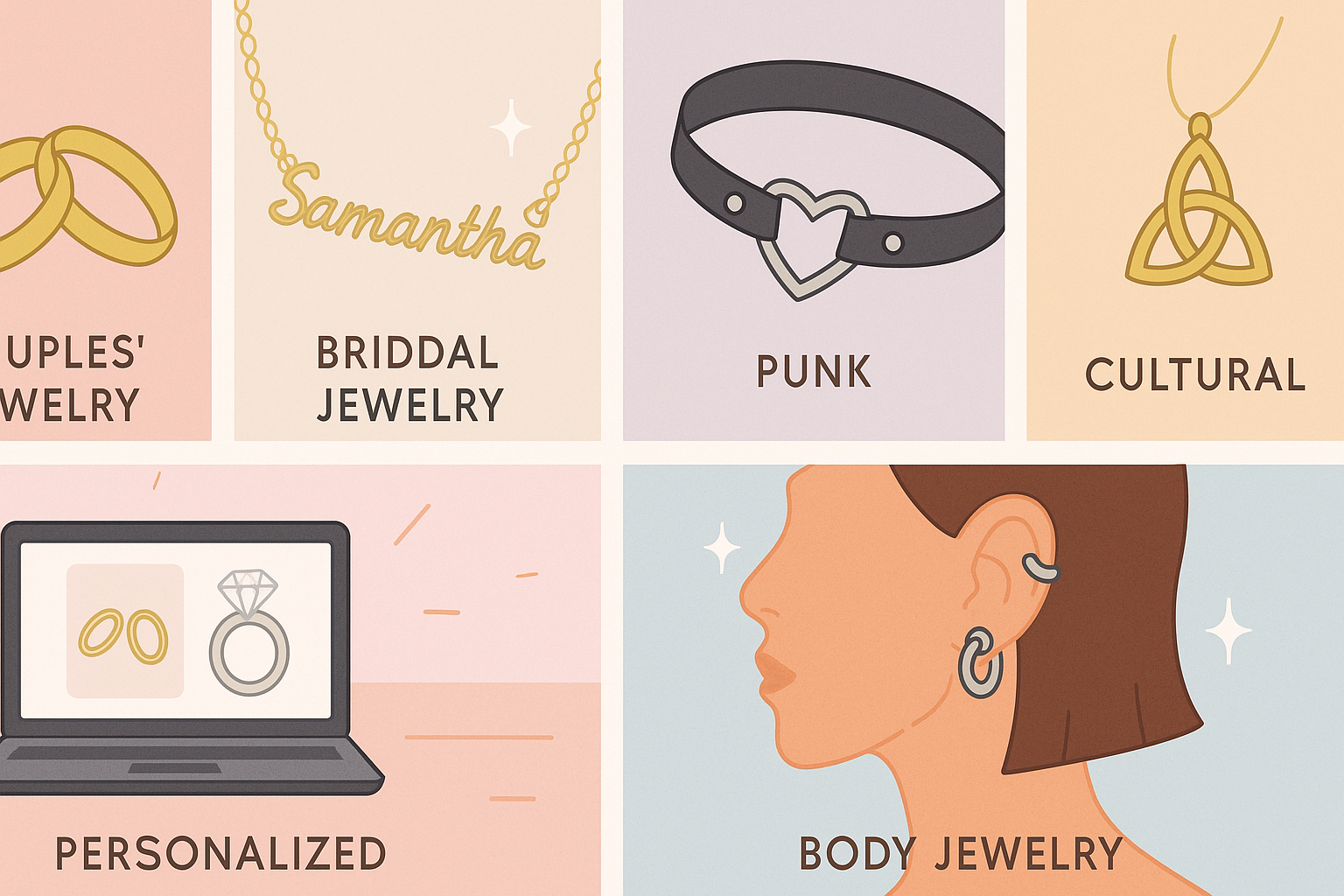
Jewelry is a broad category, so it’s smart to niche down and focus on a specific segment. Rather than trying to sell every type of jewelry, hone in on a particular style, material, or customer group. Finding a niche makes marketing much easier by letting you target a specific type of customer.
Here are some popular sub-niches in the jewelry market you might consider:
-
Couples’ Jewelry
Matching pieces (rings, necklaces) for couples; strong demand around Valentine’s and anniversaries. -
Personalized Jewelry
Name necklaces, initials, birthstones, engraved bracelets; very popular, though customization may need POD or specialized suppliers (gempages.net). -
Bridal & Engagement Jewelry
Bridesmaid gifts, engagement rings, and hair accessories, tied to weddings and events. Safer to focus on affordable or faux-diamond jewelry. -
Niche Fashion Styles
Target style tribes: gothic/punk, boho, minimalist, and eco-friendly designs. Helps attract loyal aesthetic-focused audiences. -
Body Jewelry & Piercings
Nose rings, belly bars, cartilage studs; popular among younger buyers. Stores focusing narrowly (e.g., helix hoops) can stand out. -
Religious or Cultural Jewelry
Crosses, chakra bracelets, Celtic rings, tribal pieces. Appeals strongly to faith and cultural communities. -
School/College & Sports Jewelry
Class rings, sorority/fraternity jewelry, graduation or school spirit pieces. Sports jewelry possible but watch licensing rules. -
Jewelry Bundles & Sets
Curated sets or “mystery box” bundles increase order value; shoppers love deals and coordinated designs.
When choosing your niche, play to your strengths and interests. If you genuinely love minimalist silver jewelry, start there. Also, research what’s trending and consider gaps in the market. For example, maybe you notice a lack of affordable, sweat-proof jewelry for fitness enthusiasts: that could be a niche opportunity if you find suppliers for hypoallergenic, gym-friendly pieces.
Remember, niching down doesn’t mean you can’t expand later. It simply gives you a focused starting point. You can always test other styles or niches once you gain traction. But in the beginning, a clear niche (reflected in your store branding and product selection) makes it easier to attract the right shoppers and compete in the crowded jewelry space.
Expert tip: Once you have a niche in mind, start researching suppliers or manufacturers that specialize in that niche. For instance, if you go with personalized name necklaces, find a dropship supplier who can make and ship custom nameplate pendants reliably. If you focus on body jewelry, look for a supplier like Pierce Body (known for body piercing jewelry) or oNecklace (specializing in name necklaces) to source products that fit your niche. We’ll talk more about suppliers next.
Sourcing Jewelry Products & Suppliers for Shopify Store
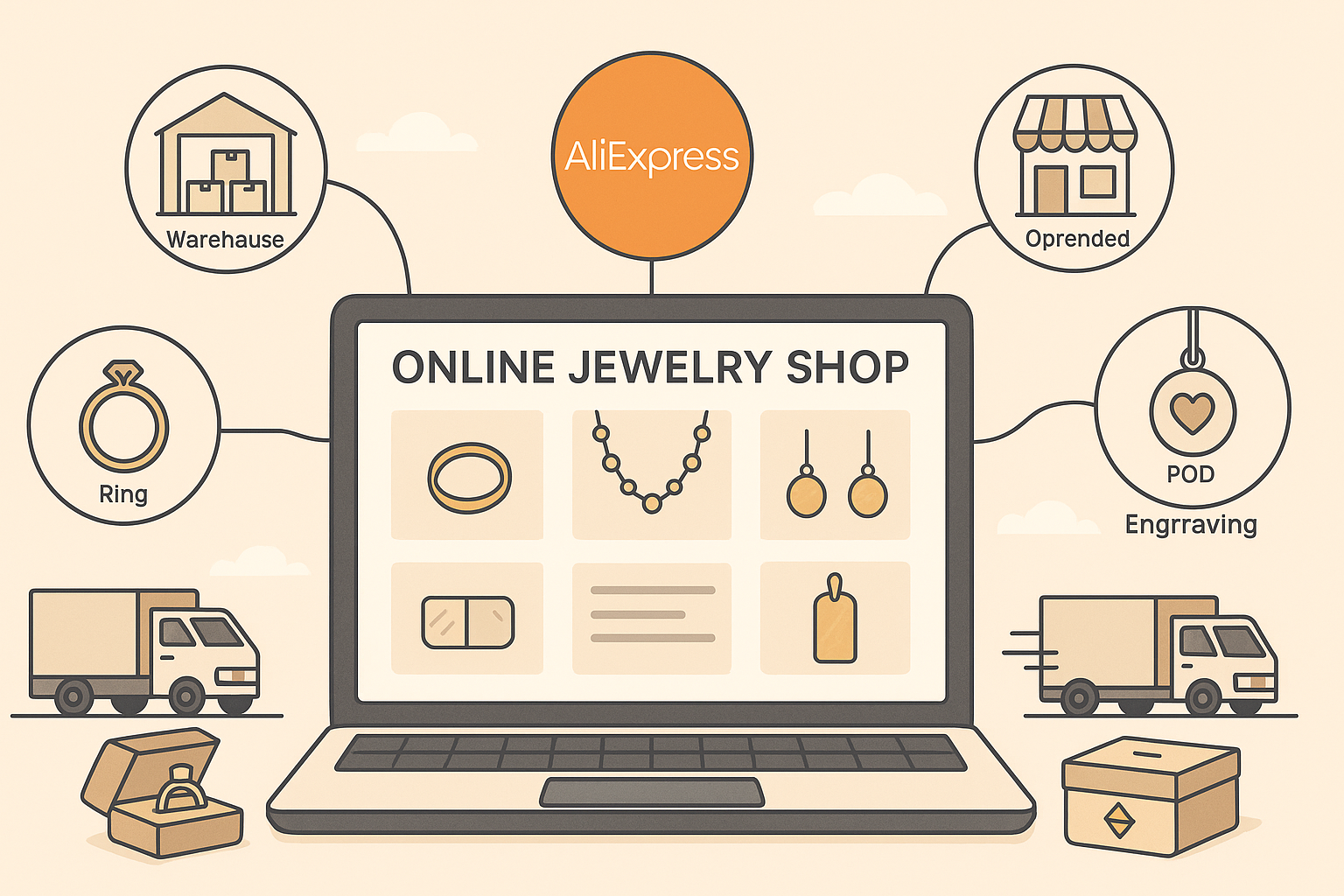
One of the trickiest parts of starting a jewelry dropshipping store is finding reliable suppliers. Jewelry quality can vary widely, and customers are very sensitive. You don’t want “gold” pieces that turn skin green, or shipping that takes 2 months. I’ve learned to be very picky when choosing who to work with.
You have a few options for sourcing products:
-
Shopify Dropshipping Apps Use apps like Spocket, DSers/AliExpress, Syncee, CJ Dropshipping, DropCommerce, and Trendsi.
-
Marketplaces & Directories
AliExpress/Alibaba: Huge range, low prices, but vet carefully to avoid poor quality
Directories like SaleHoo, Modalyst offer vetted suppliers -
Shopify Collective
Partner with established jewelry brands that fulfill orders directly. Gives access to branded, higher-quality products. -
Print-on-Demand Jewelry
Services like ShineOn for engraved or photo jewelry. Ideal for custom niches, though production can take longer.
No matter which route, do your due diligence. Order samples if possible to inspect the quality. Check supplier policies (shipping times, return policy, fees). Remember, as a dropshipper your reputation depends on the supplier’s product quality and fulfillment speed. It’s worth paying a bit more for a supplier who ships quickly from a domestic warehouse, or one with consistently good quality, to keep your customers happy.
Related: I’ve compiled a separate guide with a curated list of the best jewelry dropshipping suppliers for Shopify stores. It breaks down pros/cons of top suppliers like AliExpress, Spocket, Trendsi, CJ Dropshipping, and more. Check that out if you need ideas on where to source your products.
Once you have one or two suppliers lined up for your chosen niche, you’re ready to build your store and import those products!
Setting Up Your Shopify Jewelry Store
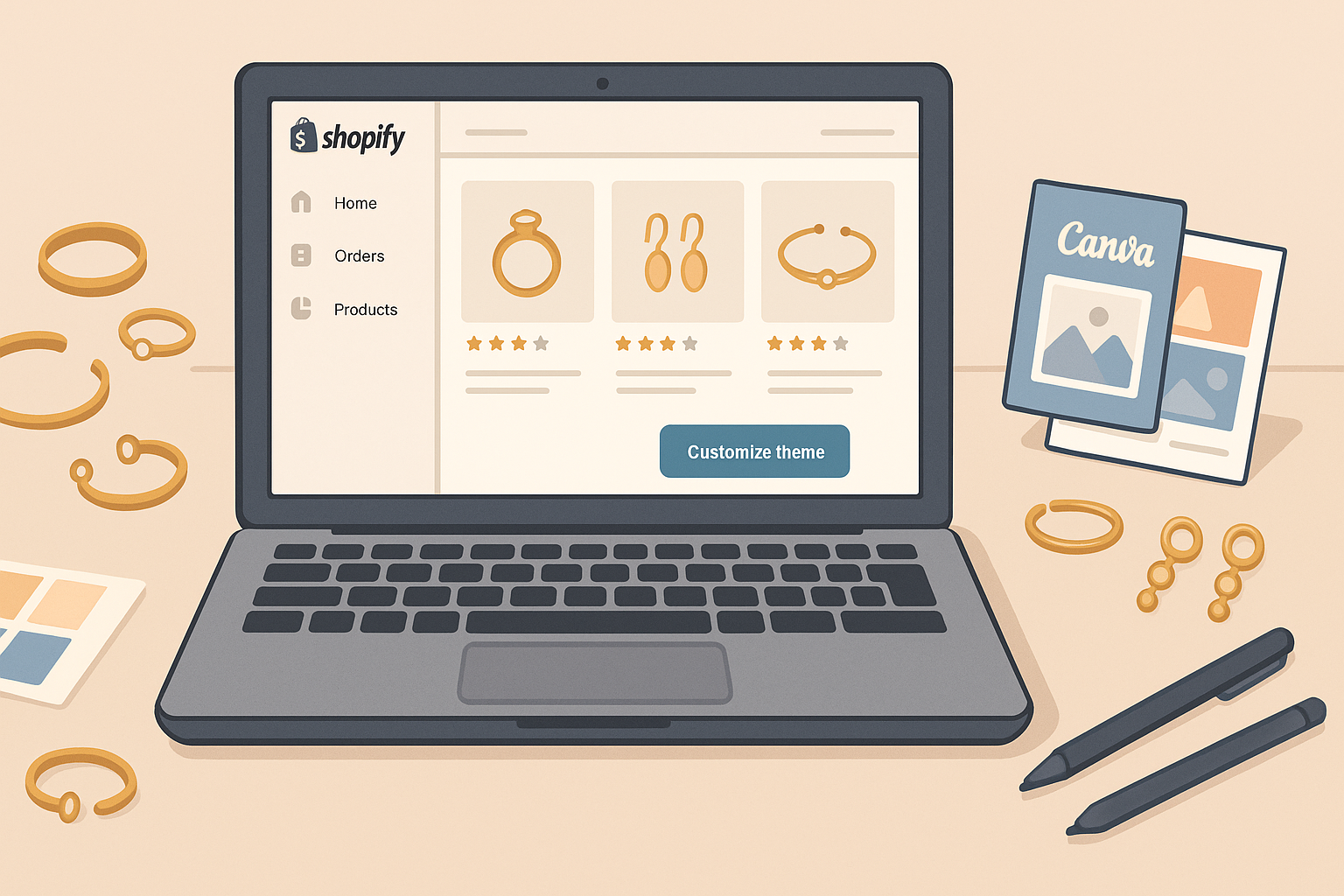
Getting your Shopify store up and running is straightforward, even if it’s your first time building a website. Shopify is a no-code platform, so you won’t need any technical skills. Here’s how to get your store set up quickly:
-
Sign Up and Start a Store
If you haven’t already, sign up for a Shopify account. They often have a free trial (like 3 days free, then $1 for the first month). The signup wizard will guide you through basic setup questions (store name, address, etc.) and bring you to your Shopify dashboard. -
Choose a Store Theme
Shopify provides a variety of free and paid store themes. In your Shopify admin, you can browse the Theme Store for designs. The great news is that Shopify has a number of themes designed specifically for jewelry businesses, which make it easy to set up a professional-looking site without design experience. You can start with a free theme like Dawn or Sense, and customize it. These are mobile-responsive and elegant by default. -
Add Essential Pages & Settings
- Domain Name: Choose and connect a custom domain. Shopify’s domain search tool can help find an available name.
- Store Settings: Input your business info, set up shipping rates, and configure taxes (if applicable).
- Payment Gateway: Activate Shopify Payments or your preferred payment gateways so you can accept credit cards. Don’t skip this. It’s needed to actually charge customers.
- Legal Pages: Generate basic policies (refund policy, terms of service, privacy) using Shopify’s generators and link them in your footer. Also, enable SSL in Shopify (usually on by default) so your site is secure.
-
Design Your Store Layout
- Logo & Branding: Add a logo (Shopify’s free maker or Canva). Pick colors/fonts to fit your vibe: black/gold for luxe, pastels for boutique.
- Homepage: Keep it simple: hero banner, tagline, featured collection or product grid. Highlight what makes your store special. Read our blog on how to build a compelling landing page.
- Navigation: Menu basics: Shop All, categories (rings, necklaces, etc.), About Us, Contact. Add Track Order if dropshipping.
- Product Collections: Group items by type (Necklaces, Earrings, Bracelets) or style (Minimalist, Statement). Makes browsing easier.
- Theme Tweaks: Use Shopify’s drag-and-drop editor for banners, text, and layout. Clean, uncluttered design lets photos shine.
-
Import & Set Up Your Products
- Import from App: Use DSers, Spocket, or similar to push products (photos, descriptions, pricing) into Shopify.
- Product Details: Edit titles/descriptions. Add materials, sizes, and story-driven copy.
- Pricing: Factor in Shopify fees; aim for 3x markup (e.g. $5–15 item → $29–39 retail).
- Photos: Use clear, high-quality images. Order samples if supplier photos aren’t good enough.
- Collections & Tags: Organize products into categories and add keyword tags.
Watch: How to SEO optimize your Shopify Store
Design Pro-Level Pages with Canvify
If you want more creative freedom than Shopify’s default themes provide, Canvify is the perfect solution. It lets you design any page in Canva, then publish it directly to Shopify as a native page, no coding or bulky page builders needed.
With Canvify, you can:
- Create stunning landing pages, lookbooks, or banners.
- Import Canva designs into Shopify with one click.
- Use Canva’s templates even if you’re not a designer.
- Add unique layouts and fonts that themes don’t normally support.
I’ve personally used it to design custom About Us pages and Homepage banners, then dropped them seamlessly into my store. It’s a huge time-saver and makes your shop stand out.
Pro tip: Canvify also offers free jewelry-specific templates, including minimalist and luxury jewelry store designs. You can edit these in Canva with your own branding, then publish instantly to Shopify. We’ll link some of these templates here so you can explore them for your store.
Marketing Your Jewelry Dropshipping Store
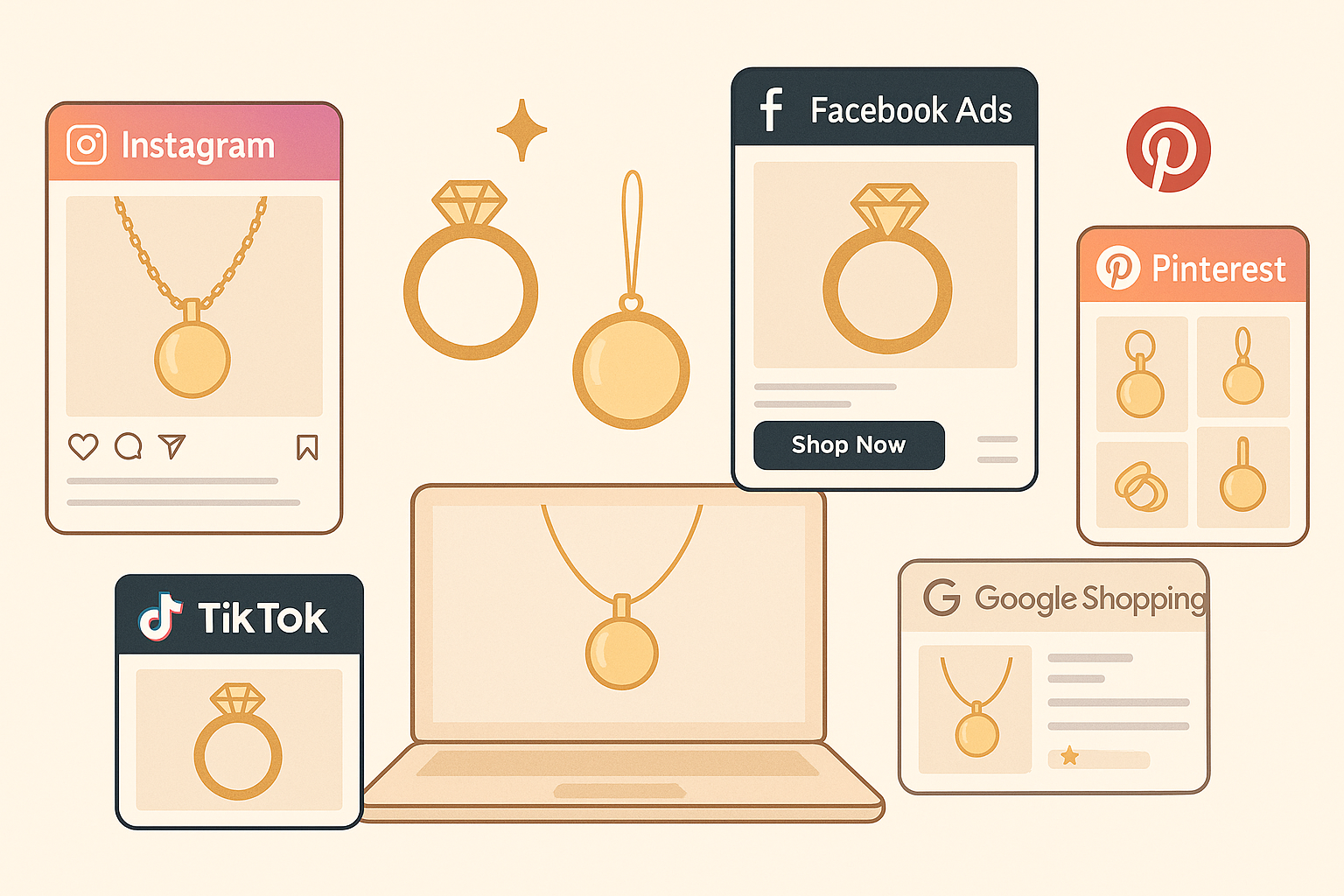
Launching your Shopify jewelry store is just the beginning. To succeed, you need to actively market your products and build trust with your audience. Here are the essentials.
Start with a Plan
Define your target audience (e.g., young women, gift buyers, college students). Keep your plan simple:
- Identify your niche and brand story
- Choose 1–2 main channels to start (Instagram, TikTok, Facebook Ads)
- Outline your strengths, weaknesses, and goals
Leverage Social Media
Jewelry is highly visual, making social platforms the best tool to showcase your products.
- Instagram: Post lifestyle shots, use hashtags, work with micro-influencers, and test ads.
- Facebook: Repurpose Instagram content, join groups, and retarget visitors with ads.
- TikTok: Share unboxings, styling tips, or behind-the-scenes clips to go viral.
- Pinterest: Create boards by style or theme; pin product images linking to your store.
- YouTube: Use unboxings or lookbooks to establish credibility long term.
Consistency and engagement are key. Reply to comments, show behind-the-scenes, and let your brand feel human.
Run Targeted Ads
Paid ads can quickly generate traffic if you have a budget.
- Facebook/Instagram Ads: Target by demographics and interests, start with small budgets, scale winners.
- Google Shopping Ads: Appear for high-intent searches like “custom name necklace.”
- SEO Basics: Use keywords in product titles, meta descriptions, and blogs for long-term organic traffic.
Build Trust & Engagement
Customers need confidence before buying from a new store.
- Social Proof: Collect and display reviews quickly.
- User-Generated Content: Encourage tagged photos, repost with permission.
- Email Marketing: Capture emails with a discount pop-up; send welcome and product highlight sequences.
- Customer Support: Respond quickly through Shopify Inbox or email.
- Trust Signals: Show SSL badges, secure checkout, and clear return policies.
Scale What Works
Monitor analytics and double down on winners:
- Push ads for best-selling products
- Create more content around popular pieces
- Drop channels that don’t perform
- Use tools like cart recovery popups or emails to reduce abandonment
Think Global, But Manage Shipping
Dropshipping allows global reach, but shipping times vary.
- Be transparent about delivery (e.g., 2–3 weeks from overseas suppliers)
- Use local warehouses (US/EU) for faster delivery where possible
- Adjust marketing by region, as styles and demand differ
Improving and Expanding Your Shopify Jewelry Business
Launching your Shopify jewelry store is just the beginning. The beauty of this business model is that you can continually improve and expand without huge costs. Here are some final tips as you grow.
As your store grows, expand carefully by adding variations of proven best-sellers or products customers request, rather than filling your catalog with random items. Keep your store mobile-friendly since most jewelry shoppers browse and buy on their phones. Fast loading images, clear fonts, and smooth navigation are essential.
To drive traffic and trust, invest in content marketing with short guides or gift lists that double as SEO boosters and shareable posts. Complement this with selective apps for upsells, wishlists, or urgency timers, but keep your site fast by avoiding unnecessary tools. Staying on top of trends is also key. Follow influencers and fashion blogs to spot rising styles and quickly adapt your catalog with supplier support.
Lastly, build a loyal community by encouraging user-generated content, running small contests, and staying active on social platforms. Listen closely to customer feedback: fix product issues quickly, double down on popular styles, and use insights to refine your store. This loop of feedback, content, and engagement will fuel steady growth.
Conclusion
Now it’s your turn. Choose that niche, build your Shopify store (don’t forget to try tools like Canvify for easy design and EmbedAny for rich content!), source quality products, and start getting your jewelry in front of the world. With low startup costs and high potential rewards, jewelry dropshipping on Shopify is an opportunity ready for you to shine 🌟.
Good luck, and happy selling!



